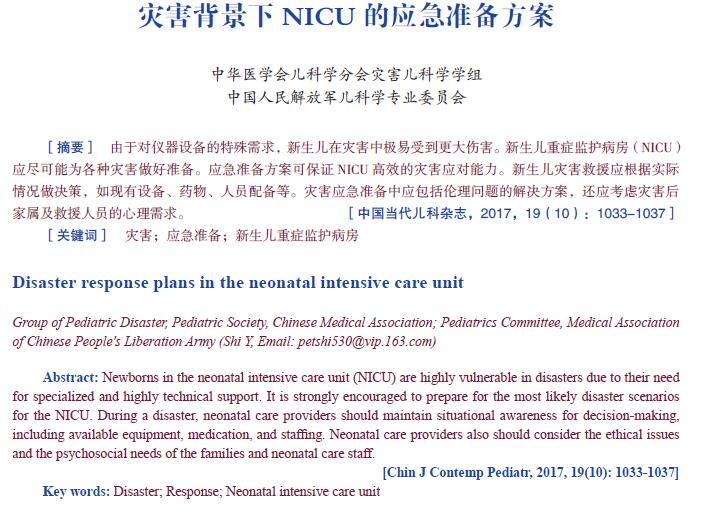 PDF(1007 KB)
PDF(1007 KB)


Disaster response plans in the neonatal intensive care unit
Group of Pediatric Disaster Pediatric Society Chinese Medical Association, Pediatrics Committee Medical Association of Chinese People's Liberation Army
Chinese Journal of Contemporary Pediatrics ›› 2017, Vol. 19 ›› Issue (10) : 1033-1037.
 PDF(1007 KB)
PDF(1007 KB)
 PDF(1007 KB)
PDF(1007 KB)
Disaster response plans in the neonatal intensive care unit
Newborns in the neonatal intensive care unit (NICU) are highly vulnerable in disasters due to their need for specialized and highly technical support. It is strongly encouraged to prepare for the most likely disaster scenarios for the NICU. During a disaster, neonatal care providers should maintain situational awareness for decision-making, including available equipment, medication, and staffing. Neonatal care providers also should consider the ethical issues and the psychosocial needs of the families and neonatal care staff.

[1] Barfield WD, Krug SE, Kanter RK, et al. Neonatal and pediatric regionalized systems in pediatric emergency mass critical care[J]. Pediatr Crit Care Med, 2011, 12(6 Suppl):S128-S134.
[2] Jamieson DJ, Rasmussen SA, Uyeki TM, et al. Pandemic influenza and pregnancy revisited:lessons learned from 2009 pandemic influenza A (H1N1)[J]. Am J Obstet Gynecol, 2011, 204(6 Suppl 1):S1-S3.
[3] Zapata LB, Kendrick JS, Jamieson DJ, et al. Prevention of novel influenza infection in newborns in hospital settings:considerations and strategies during the 2009 H1N1 pandemic[J]. Disaster Med Public Health Prep, 2012, 6(2):97-103.
[4] Devereaux AV, Dichter JR, Christian MD, et al. Definitive care for the critically ill during a disaster:a framework for allocation of scarce resources in mass critical care:from a Task Force for Mass Critical Care summit meeting, January 26-27, 2007, Chicago, IL[J]. Chest, 2008, 133(5 Suppl):51S-66S.
[5] Kissoon N; Task Force for Pediatric Emergency Mass Critical Care. Deliberations and recommendations of the Pediatric Emergency Mass Critical Care Task Force:executive summary[J]. Pediatr Crit Care Med, 2011, 12(6 Suppl):S103-S108.
[6] Kanter RK, Cooper A. Mass critical care:pediatric considerations in extending and rationing care in public health emergencies[J]. Disaster Med Public Health Prep, 2009, 3(Suppl 2):S166-S171.
[7] Gardner AH, Krug SE. Pediatric emergency preparedness:are we ready?[M]//Graciano AL, Turner DA. Current Concepts in Pediatric Critical Care. Mount Prospect, IL:Society of Critical Care Medicine, 2015:147-158.
[8] Gausche-Hill M, Ely M, Schmuhl P, et al. A national assessment of pediatric readiness of emergency departments[J]. JAMA Pediatr, 2015, 169(6):527-534.
[9] Cohen R, Murphy B, Ahern T, et al. Regional disaster planning for neonatology[J]. J Perinatol, 2010, 30(11):709-711.
[10] Daniels K, Oakeson AM, Hilton G. Steps toward a national disaster plan for obstetrics[J]. Obstet Gynecol, 2014, 124(1):154-158.
[11] Bohn D, Kanter RK, Burns J, et al. Supplies and equipment for pediatric emergency mass critical care[J]. Pediatr Crit Care Med, 2011, 12(6 Suppl):S120-S127.
[12] Tegtmeyer K, Conway EE Jr, Upperman JS, et al. Education in a pediatric emergency mass critical care setting[J]. Pediatr Crit Care Med, 2011, 12(6 Suppl):S135-S140.
[13] Phillips P, Niedergesaess Y, Powers R, et al. Disaster preparedness:emergency planning in the NICU[J]. Neonatal Netw, 2012, 31(1):5-15.
[14] Disaster Preparedness Advisory Council. Medical countermeasures for children in public health emergencies, disasters, or terrorism[J]. Pediatrics, 2016, 137(2):e20154273.
[15] Tsai CW, Morris S. Approval of raxibacumab for the treatment of inhalation anthrax under the US Food and Drug Administration "Animal Rule"[J]. Front Microbiol, 2015, 6:1320.
[16] Mason KE, Urbansky H, Crocker L, et al. Pediatric emergency mass critical care:focus on family-centered care[J]. Pediatr Crit Care Med, 2011, 12(6 Suppl):S157-S162.
[17] Schonfeld DJ, Demaria T; Disaster Preparedness Advisory Council and Committee on Psychosocial Aspects of Child and Family Health. Providing psychosocial support to children and families in the aftermath of disasters and crises[J]. Pediatrics, 2015, 136(4):e1120-e1130.
[18] Janvier A, Lantos J; POST Investigators. Ethics and etiquette in neonatal intensive care[J]. JAMA Pediatr, 2014, 168(9):857-858.
[19] Ytzhak A, Sagi R, Bader T, et al. Pediatric ventilation in a disaster:clinical and ethical decision making[J]. Crit Care Med, 2012, 40(2):603-607.
[20] Burkle FM Jr, Argent AC, Kissoon N, et al. The reality of pediatric emergency mass critical care in the developing world[J]. Pediatr Crit Care Med, 2011, 12(6 Suppl):S169-S179.
[21] American Academy of Pediatrics Committee on Fetus and Newborn, Bell EF. Noninitiation or withdrawal of intensive care for high-risk newborns[J]. Pediatrics, 2007, 119(2):401-403.
[22] Madrid PA, Schacher SJ. A critical concern:pediatrician self-care after disasters[J]. Pediatrics, 2006, 117(5 Pt 3):S454-S457.
[23] Barfield WD, Krug SE; Committee on Fetus and Newborn, et al. Disaster preparedness in neonatal intensive care units[J]. Pediatrics, 2017, 139(5). pii:e20170507.